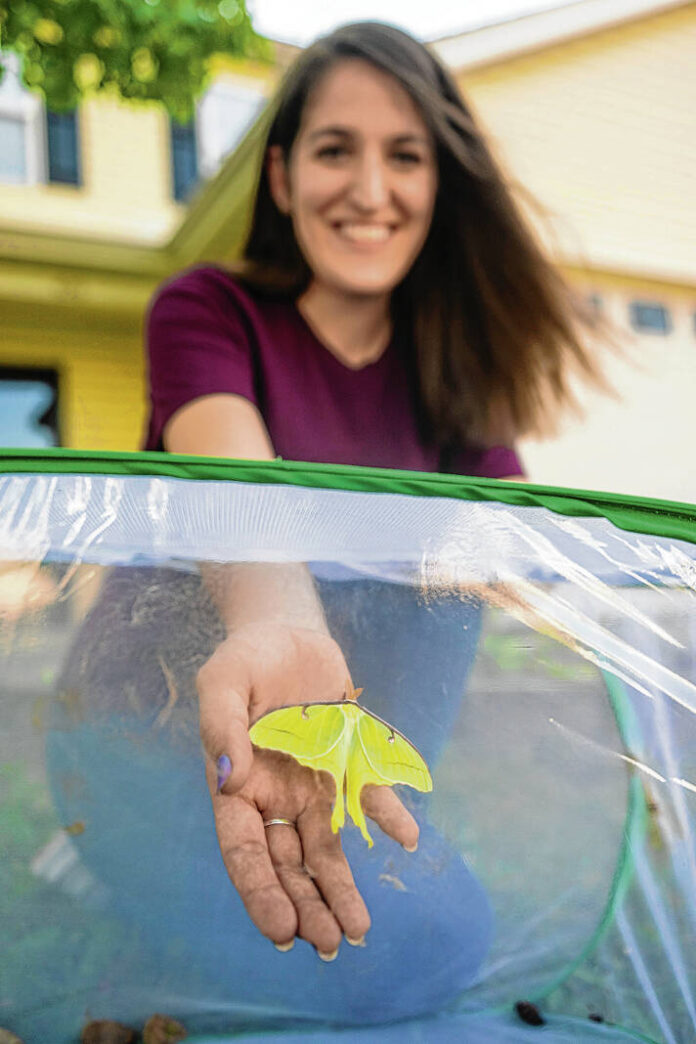
Rachel Holmes poses with one of the many luna moths she has taken under her wing to nurture and help hatch. The Greenfield Parks and Recreation teacher has had much success hatching these colorful specimens at her home in Greenfield. Saturday, Sept. 17, 2022.
GREENFIELD — Rachel Homes was absent-mindedly scrolling through Facebook Marketplace, looking for nothing in particular, when something unique caught her eye — a listing for luna moth larvae.
Intrigued, the Greenfield art teacher took the bait and clicked, and she’s so glad she did.
Since that fateful day at the start of summer Holmes has been raising luna moths, gently nurturing them from larva to caterpillar to chrysalis to cocoon before they emerge as vibrantly colored moths with bright green wings and pinkish legs.
With a wingspan as big as her hand, the lime-green moths are accentuated by striking maroon markings at the top of their lime-green wings. While their average wingspan is 4.5 inches, some luna moths measure up to seven inches wide.
Holmes has been fascinated throughout the whole process, right up to the part where the moths emerge from their cocoons and energetically vibrate to warm and dry their wings so they can fly away to wherever moths may go.
Of the 20 eggs she purchased for a total of $10, only 14 were viable, but Holmes is thrilled with the success rate.
“He’s gorgeous,” she said, of the latest colorful moth to emerge from its cocoon.
As of Wednesday, Sept. 21, Holmes had released seven full-grown moths and had seven cocoons left to hatch.
While she originally wanted to raise the moths as a fun mother-son activity with her 8-year-old son, Elliott, the second-grader gradually lost interest. His mother, however, has enjoyed every minute of it.
“It’s been a blast,” said Holmes, who teaches art classes through Greenfield Parks & Recreation.
“From start to finish it’s been the coolest process,” she said.
When Holmes first picked up the eggs from the Greenfield woman selling the larvae, each was about the size of a grain of rice. “By the time they were finished they were as long and thick as my pointer finger. It was wild,” she recalled.
It took about three weeks for the eggs to transform into a chrysalis, and five to six eggs for each chrysalis to turn into a caterpillar.
Holmes has photographed every stage along the way.
When they were caterpillars she kept the growing creatures in a tiny plastic tub. When they entered the chrysalis phase, she moved them into a one- by two-foot mesh habitat she bought online.
“When they first emerge they’re all crumpled and they take a little time to rest while their wings kind of straighten and fill out,” said Holmes. “I let them stay until it gets dark out so I can release them outside. Their chances are much better if they’re released at night.”
Caring for the creatures has been a labor of love, said Holmes, who “went down a rabbit hole” searching countless websites for tips on how to grow the larvae into thriving moths.
“It’s just really fascinating to watch them grow and to see how quickly they grow. They would start out tiny and before you know it they’re huge,” she said.
One day she was feeding the family of caterpillars a leaf from the sweet gum tree in her front yard that would last a couple of days, “and suddenly I’m cutting big 12 to 18-inch branches off and they were going through it in a day and a half,” she said.
She’s joyfully watched seven moths emerge from their cocoons over the past month, and expects the rest to emerge any day now.
“It could be anytime,” she said. “In the last day or two I’ve heard quite a bit of motion from a couple of them, but I expect I will have a couple more moths hatching in the new couple of days.”
While the luna moths are eye-catching and colorful, Holmes said people don’t often spot them because they’re nocturnal and their lifespan is less than one week.
“By the time they get to the moth stage they literally just reproduce and die. I think their main purpose is serving as a food source,” said Holmes
Because of their short lifespan, luna moths never even get the chance to eat, as they emerge without a mouth or digestive system.
According to the Urban Ecology Center, female luna moths will lay about 200 eggs at a time. The larva will hatch after 10 days and begin eating the leaf on which its egg was laid.
During its larval phase, each caterpillar will spin silk from its mouth, pupate and make a cocoon, where it stays for two to three weeks before emerging and living its relatively short life as a moth.
Lais McCartney, Agriculture and Natural Resources Educator for the Purdue Extension office in Greenfield, said Holmes is the first person she’d heard of raising luna moths at home.
“That’s cool. I’ve never heard of anyone raising them,” she said.
While they have a short life span, McCartney said the caterpillars provide a great food source for songbirds.
The caterpillars munch on a variety of tree leaves like white birch, wild cherry and sweet gum, but they don’t do the trees any harm, she said. “Tree leaves that have bites out of them mean (the caterpillars) are part of the local ecosystem and are eventually feeding the birds we want to see in our yards.”




